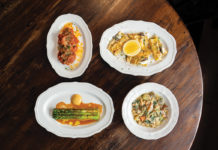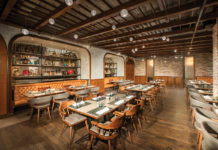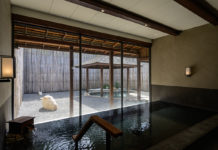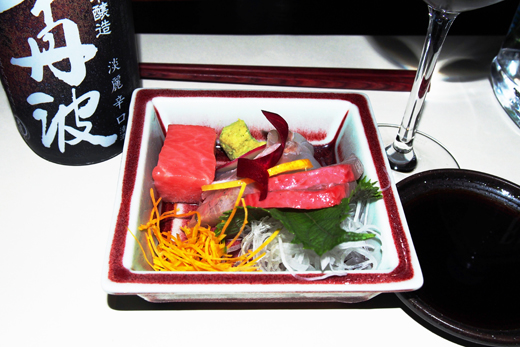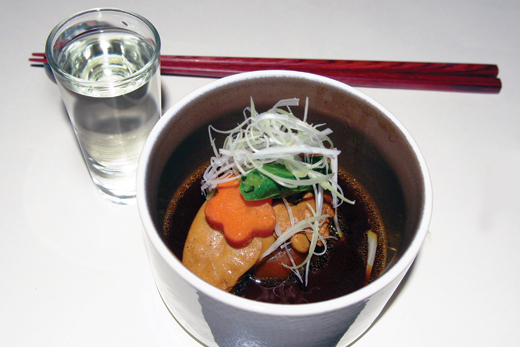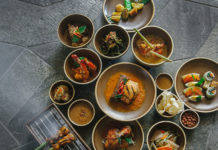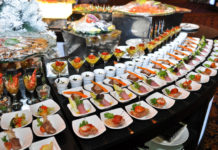TAKING SAKE TO ANOTHER LEVEL
ENMARU, JAKARTA’S HOTTEST AND HIGHEST JAPANESE RESTAURANT, RECENTLY HELD AN EXQUISITE SAKE PAIRING DINNER TO SHOW HOW THE RICE WINE CAN ENHANCE DISHES JUST AS BEAUTIFULLY AS ITS GRAPE-DERIVED COUSIN.
Wine pairing is a familiar concept to most people – we all love a full-bodied Cabernet Sauvignon with a juicy rib-eye steak or a crisp Riesling with freshly caught crab. But sake, despite being a rice wine, is not usually thought of in the same context, especially outside of Japan. For those with little knowledge of it, sake may seem less nuanced than other wines, but experts will tell you its countless varieties offer the same complexities and pairing possibilities as the red and white kind.
The team at Enmaru Japanese restaurant in Jakarta set out to educate the capital’s foodies with a sake pairing dinner held on September 18. Guest chef Katsuhiko Yamamura from Akane restaurant in Singapore collaborated with Enmaru’s executive chef Takashi Tomie to produce nine courses of fine Japanese food, served with seven premium varieties of sake.
Enmaru is a member of ALTITUDE, a group of three fine-dining venues located on the 46th floor of The Plaza tower in Central Jakarta. Joining Enmaru at ALTITUDE are North Italian restaurant Gaia and modern Australian steakhouse Salt grill, all of which enjoy panoramic views of the city centre.
The meal at Enmaru began with a chilled glass of Hana Awaka, a sparkling sake served in a pale pink bottle. This type of sake is said to be popular among women, thanks to its light alcohol content, sweet flavour and pretty-in-pink packaging. It made for a celebratory start to the meal, cleansing the palate for the range of sensations to come.
The first pairing on the menu matched a glass of Shirakabegura Kimoto Junmai sake with a petite portion of sea urchin served with grilled eggplant and yam. Alongside the sea urchin, the sake tasted smooth and fresh, but its flavour changed dramatically in the next pairing.
Poured into a shot glass instead of a wine glass, the same sake took on a hot and punchy flavour when paired with a marinated oyster, tempura-battered vegetables and a bowl of thinly sliced rare beef, which were served together in a wooden box lined with origami paper.
Some explanation for the change in flavour lies in the sake’s name – “kimoto” means it uses a traditional yeast starter, while “junmai” means it’s purely rice-based, with no added alcohol. The purity makes it a versatile partner for many dishes, able to adapt to the flavours it’s paired with rather than overpower them.
Another versatile variety on the menu was the Karatanba Honjozo, a fragrant sake brewed with added water and alcohol. The same sake was served in two ways to match two vastly different dishes.
First it was served cold with a platter of Sashimi Moriawase, the ingredients of which had arrived fresh from Tokyo’s Tsukiji fish market earlier that day. Chef Yamamura explained that sake is generally served cold with sashimi to cleanse the oily and creamy feel of the raw fish. The sake must also be unobtrusive, to allow the delicate flavours of the seafood to shine.
For the next course, the same sake was served warm to accompany a hot slice of steamed foie gras served with radish and soy sauce. With such rich flavours to contend with, the sake was heated to give it a more powerful presence.
Also on the menu was the Japanese version of a steak and good rare slices of grilled wagyu beef seasoned with shaved yuzu salt and served with a hard-hitting Dassai 23 Junmai Daiginjo. The number on the bottle means the sake was distilled 23 times, giving it a bold and fruity flavour to rival any good Shiraz.
Finally, the sweeter side of sake was revealed with a glass of Kawasemi No Tabi, a dessert variety brewed in Niigata prefecture in northwestern Japan. Matched with a hand-rolled mochi cake filled with red bean and strawberry, the Kawasemi showed its characteristic long aftertaste, providing a sweet finale to the meal.
It may be some time before sake achieves the same level of global appreciation as wine, but as Enmaru’s pairing dinner managed to show, the drink has the diversity and versatility to make connoisseurs of us yet.
(www.altitude.co.id)



